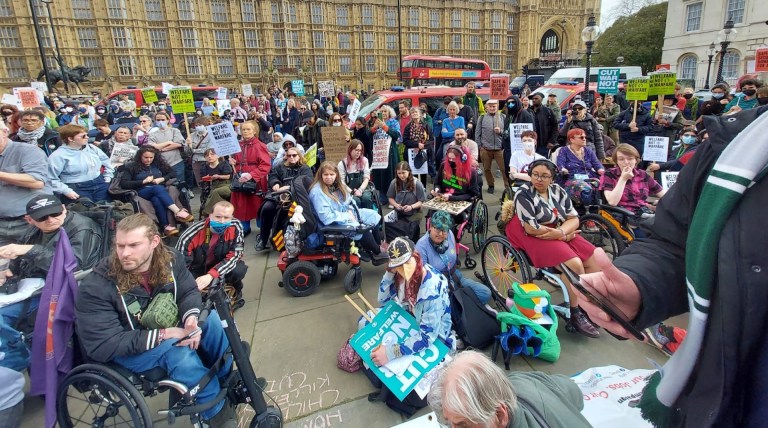Finally, the substantial risk regulations, under which people whose mental health would be harmed by undertaking work-related activity are instead placed in the LCWRA group, would only apply in exceptional cases. 163,000 people are expected to be impacted by this change by 2028/29, with the OBR predicting 5,100 more people will find work in that time.
Some disabled people would get hundreds of pounds a month less under these reforms than they would at the moment. The measures will not affect existing claimants, but they would impact those applying for the first time from next year, and also anyone who comes off the benefit but then later reapplies for it.
“I’m kind of in and out of work, depending on what level of distress I’m experiencing,” said Ellen Clifford of Disabled People Against Cuts, who is currently in the LCWRA group. The proposed changes to the substantial risk regulations mean if she reapplied for benefits in future she could find herself in the LCW group instead.
“Although it says you wouldn’t have to do any mandatory activity, it does say that you’ll be under a work coach. And I don’t have that stress now. And actually what I find is that I’m doing the campaigning work, and I’m getting bits of paid work through that. So I’m slowly getting back to work. But that’s because I’ve got the safety net of that extra income, and not the stress of having to engage with a work coach.”
Clifford is bringing a judicial review of the DWP’s consultation exercise regarding its proposals. “One of the things I really struggle with is having to attend appointments. Because I can be so anxious, it takes me an unpredictable amount of time before I can get up and washed and dressed and leave the house.
“And I know that the Jobcentre is very strict with appointment times. And even if I wasn’t subject to sanctions, it would still be the fact that I’m having to push myself to engage with someone. It’s just those kinds of things that I find hold me back from being able to get on with trying to progress back into employment.”
James, who is 47 and whose name has been changed to protect his identity, worked for ten years as a manual labourer in retail and logistics. Years of pushing large crates around ended up damaging the Achilles tendon in both his feet, leaving him struggling to walk ten metres and having to use a mobility scooter. He also has mental health issues. He is now in the LCWRA group.
“Realistically, if the training etc was there, I’ve got another 20 years in me. But that assistance isn’t there to enable me to do that,” he told the Big Issue.
The DWP justifies its disability benefit cuts on the basis that disabled people can take advantage of the rise of work-from-home jobs. But James said the problem is the employers themselves.
“At this precise moment, I and most disabled people feel that the Equality Act is no more than a bit of paper. There is no enforcement there. As far as companies taking people like me on, even working from home, goes, it’s normally non-existent. Partly because of that one piece in the legislation that says ‘reasonable adjustment’. Now in legal terms, there is no definition of ‘reasonable’. So it just goes out the window. They don’t want to know at all.”
For the last four years James has been the disability officer at his constituency Labour Party branch. In that role he has got to know hundreds of disabled people across the area, inside and outside the party. He says only one of them has managed to find work.
Louise Murphy, senior economist at the Resolution Foundation think tank, said: “The government has announced a wide range of benefit reforms and wider consultations over the past year – which is understandable given the alarming rise in economic inactivity and uptick in claims for health- and disability-related benefits in recent years.
“While some proposals are very open-ended, others are more concretely geared towards saving money. The planned reforms to the work capability assessment fall into the latter camp, as restrictions over eligibility will inevitably cause cash losses of up to £416 per month for some individuals.”
A DWP spokesperson said: “We are taking the long-term decisions to help everyone who can work to do so, improving lives and growing the economy, while maintaining protections for those who need them.
“Our landmark welfare reforms will cut the number of people due to be put onto the highest tier of incapacity benefits by over 424,000 and instead give them personalised support to help them move closer to employment, while our Chance to Work Guarantee will enable millions of people to try work without fear of losing their benefits.”
Do you have a story to tell or opinions to share about this? We want to hear from you. Get in touch and tell us more.










